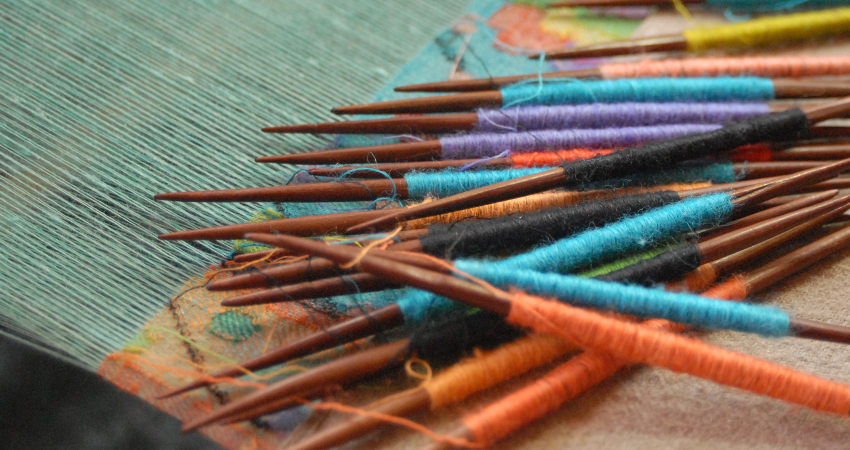
Paper Works !!!
In a candid chat with Pooja Sriram, owner, Orange Peel, she tells us how social networking and word of mouth are some simple yet creative promotional strategies for business ventures.
Pooja, a 26 year old entrepreneur always had an eye for things unique and creative! “Orange Peel, is one of those creative ideas that actually progressed from an idea to a product and now a business.” Orange Peel is like her in-house creative incubator where, she with her mother and sister, creates beautiful jewellery mostly earrings for now, made from paper in vibrant colours.
“Orange Peel was born in March 2013, just like a hobby. With more people appreciating our work, we decided to name our brand. Before we knew it, we had a logo, a full-fledged Facebook page and several ‘likes’ pouring in! Orange Peel is that little nut-shell that has integrated my love for colour, creativity and social networking.”
Orange Peel also offers Pooja a canvas to bring forth her photography skills as well as marketing tactics. Her large network of friends and acquaintances are now her customers and sure her teachers are proud to see her put the knowledge imparted to use.
What inspired you?
The idea was a pure result of a visit to the many Santes and flea markets that are held in Bangalore. The idea of making paper jewellery is not new; but our products are 100% handmade and the efforts put in to come up with new designs, unique colour schemes, and attention to detail, make us different from the rest. And for the sourcing of material, I am thankful for Mom’s bargaining skills that make the procurement of materials an easy task!
Who are your target customers?
As of now Orange Peel only has paper jewellery which makes women our target customers. We have girls as young as 4 to women as old as 60 buying our products. However, we also have some adorable men buying these as gifts for their wives, girlfriends, daughters and moms! We have plans of expanding our portfolio with hair accessories, key chains, magnets, home décor products, etc and hope to have a more diverse group of customers.
What is the marketing model that you follow?
Orange Peel started just 3 months ago and all our marketing is through word of mouth and the god of all social networking sites – Facebook. Using our own PR skills and Social network Orange Peel has had more than 200 likes in 2 months and the page had more than 3000 views! One strategy that worked for us was to get single boys to buy or promote Orange Peel products with all the girls at their workplace.
How do your customers get the products since these are small goods purchased online?
I like meeting my customers. I either get them to pick it up from my homes, we work from both my Mom’s and Mother in Law’s place, or I meet them and deliver it to them. In case of orders overseas, I have got relatives and friends travelling to deliver my little packets. With our orders increasing, we will soon start couriering them.
About the Author: Pooja Sriram pursued her MBA in Advertising & Marketing Communication from the Manipal Institute of Media and Entertainment (MIME) and is currently an Associate Manager- Product Marketing at a Global Mobile VAS organisation- Onmobile Global Ltd. Orange Peel products range from Rs.29-Rs.149. Check them out at www.facebook.com/orangepeelswirlart

The Cashmere Touch of the Pashmina
Most of us who are able to look beyond the insurgency in Kashmir view it as a place with immense natural beauty – a land of stunning lakes and mountains! Nothing epitomizes the glorious history of the Himalayan craftsmanship, as warmly and beautifully as does the Pashmina. Pashmina, prized by kings and nobles and the pride of a bride’s trousseau even now, is often referred to as the ‘diamond’ of all fibres. The artisans of Srinagar narrate the stories of their forefathers who served the Mughals and made a single shawl in a 6-12 month period. Even today their fine art exists and some shawls take months to be completed.
The splendid craftsmanship
Pashmina mainly comes from the Himalayan region and is known for its warmth and long life. The uniquely soft fleece is hand-combed every spring from the soft wool from the neck and chest of the Capra Hircus, the Himalayan mountain goat. These goats are reared in herds at altitudes over 14000 feet in the arid plateaux of Ladakh, Tibet and Mongolia. The thermo conductivity of the wool is one of the best in the world as it survives the animal at -40 degree centigrade in virgin pollution-free climates of the world. Pashmina fibre is 12.5 – 19 microns in thickness (1/6th the size of human hair which is 75 microns thick) making it supremely soft.
Spinning the yarn
The production of Pashmina shawls in Kashmir is more or less concentrated in Srinagar. Even the raw material traders, small and big manufacturers are situated in Srinagar. The hand spun Pashmina yarn goes through various stages of dyeing, sizing, warp preparation and finally the actual weaving before the wondrous transformation from the unruly mass of fibre to a textile of unique softness, warmth and beauty can be seen. Even after weaving the unique process of tweezing, clipping and washing in the waters of Jhelum gives the Pashmina shawl its royal touch. Due to the requirement of high quality skills in each process the production involves many artisans. Thus the production process is fragmented into various sub-processes. Each type of artisan does their work and then the material is passed on to the next category. The production is controlled by the manufacturers who invest their capital. Earlier the raw material-end till the manufacturing of yarn was controlled by Poiwanis (Raw material dealer) and the finished product-end was controlled by the big manufacturers. But this division has become blurred today as many Poiwanis are into complete manufacturing and the big manufacturers also deal in raw material.
Amongst the artisans the spinners are the largest group, constituting 65-75% of the total number of artisans. The spinning is done completely by women and is one of the most difficult tasks in the value chain. The cleaning and de-hairing of raw pashmina was also earlier done by the spinners but today it has been fully mechanised. The weavers are the next largest in numbers and represent 15-20% of the artisans. The weavers are generally more knowledgeable and enterprising than the other kinds of artisans. Thus many of them graduate from weavers to small manufacturers. Embroiderers are the third in hierarchy of artisans. The present structure of production is described through the diagram below:
The weave
All hand-woven Pashmina fabrics are traditionally woven in the twill weave, with different permutations of it. This can be classified into three categories:
- Saadi – a simple and un-patterned hand-woven fabric employing a four shaft twill weave and various combinations
- Kani- a highly decorative brocade textile, made on exactly the same loom as the one used for plain Pashmina fabric, but with woven patterns
- Amlikar- usually a plain Pashmina, embroidered upon with very fine Kashmir mulberry silk, Pashmina or cotton thread
It takes the wool from four and over 200 man-hours (spinning, weaving, dying and decorating, finishing) to make just one pashmina shawl. Hand cleaning and spinning the wool for a single Pashmina takes 15 days, so naturally the labour-intensive production is reflected in the price. An original Kashmiri handmade Pashmina may cost between Rs.5,000 and Rs.1,00,000 depending on the level of craftsmanship. Though the craft is under threat from various spurious shawls in market which are sold in the name of Pashmina at cheap prices, the thousands of artisans have maintained their tradition since ages and should be able to protect it even in this globalised world. The artisans in Kashmir say that Pashmina is Pashmina not because of the material but because of the process. Thus one has to visit the bye-lanes of Srinagar to experience the magic of Pashmina.
About the author: Arindam Dasgupta, is the CEO of Tambul Plates Marketing Pvt. Ltd. and is an expert in micro enterprise development. He is currently based out of Barpeta, Assam

The Fear of Social Entrepreneurship
Does a failed entrepreneur exist? Because no one ever introduced themselves to me as a failed one! An entrepreneur does not take risks, he manages risks. An entrepreneur would find the strengths and opportunities in accordance to the area where the business opportunity is identified therefore the idea behind our entrepreneur is not formulaic.
Social entrepreneurship
In case of social entrepreneurship the problems often identified and discussed on forums are of limited liability for the ‘social entrepreneur’ and unlimited liability for the already impoverished community. In India, social entrepreneurship is ashamed of a success rate of 3%. Grassroots interventionists shirk from taking active initiatives or even providing inspiration because of the lack of knowledge on business management, development strategies and local economy analysis. The core motive of the interventionist tends to dwindle because it lies in a vulnerable place in the community and stems from the daily battle for economic betterment.
Therefore, with the investment of only the time of the self-sacrificing interventionist, not his own philanthropy (read capital) nor the risk or credit of the gravely indebted farmers, one may find social entrepreneurship to be a rising challenge for the handicapped interventionist.
Entrepreneurship in agriculture
Agriculture is not just about good agriculture anymore; it is about more complex avenues for developing agriculture, which requires entrepreneurial abilities to corroborate already existing systems and dissuade them from dependence on farm income.
The major enterprising skills as well as market linkages can identify agriculture and to some extent semi-processing units within the rural sector which can further lead to forward linkages in the rural non-farm sector, thus luring trade related commerce to be on the rise. This is only a certainty if agricultural credit is available to the farmers. However the scope for saving and availing credit for the farmer is a large potential goldmine for money creation in the rural areas, as the ability and willingness to repay for the farmer is very high, provided they are organized.
The reason behind this seemingly distorted analogy about the willingness of the farmer to repay is the more obvious willingness to grow and be more closely associated with the bank that gives interests to the farmers at a lower rate than the local money lender. Thus using the mainstay of the rural economy which is agriculture to spur the rural non-farm sector, it will also help increase the agricultural productivity.
The existing dual economies
The dual economy model does draw sweeping conclusions which may not be applicable to all developing countries alike. But take for instance in case of Maharashtra where it is of great use to observe a dual economy, with the financial capital of the country- your very own Bombay as well as the highest levels of malnourishment in the country- Nandurbar district being just a few 100 kilometres apart. There is a greater emphasis on enhancing the capabilities of the village.
The scope for Social entrepreneurship is immense but the risk isn’t that of the interventionists, it is to a large extent that of the community involved. A community so scared of risk that a lifetime of drudgery and servitude seems better than the effort invested in trying to find a way out!
About the author: Ishani Tikku, has studied M.A. Social work in Rural Development at Tata Institute of Social Sciences and is now working with the Maharashtra State Rural Livelihood Mission

Ten Questions to decide if you are an Entrepreneur
Note: Views expressed are personal and not meant to offend anyone
The fact you’re currently logged on to the entrepreneur’s e-mag Outbox, is enough guarantee to the fact that there is an entrepreneurial bug creeping somewhere inside you right now! And no doubt you want to know more about how it can help you. Yet, you’re constantly filled with doubts as to whether or not you can be an entrepreneur. It’s time to stop wondering! Score yourself on the following ten questions and discover the real you.
Are you uncomfortable with the status quo?
Do you constantly feel an urge to change the world around you or are you happy with the way things are in your life and surroundings? If you’re happy with how everything has been done by God and men, can adjust easily everywhere and see no need to change or induce changes, you are not an entrepreneur. An entrepreneur is a change maker. He improves things. He’s never satisfied with who he is and grows agelessly. He’s never satisfied with the condition he is in and improves it untiringly!
Do you spot opportunity?
Do you find yourself looking at empty spaces and spotting opportunities?
Are you a bundle of ideas?
Are you an inactive listener to your friends/family/work discussions or do you participate and come up with ideas sometimes, even if they are fancy? If you extend your imagination and stretch it beyond limits, only then can you find the entrepreneur within you. If you find yourself lying on your bed or sitting in your study, apparently doing nothing but actually thinking about a particular problem, issue or situation? If you do, you’re on your way to generating ideas and becoming an entrepreneur eventually.
Do you attract criticism?
A good way to find out whether there is an entrepreneur within you is to notice how many ‘people’ are criticizing you. Generally, all good ideas attract discouragement from ‘people’. Even though this is not a sure shot way, it happened to more than 90% of the entrepreneurs. Weigh their arguments, pay heed to the ones you find sense in, make amendments if necessary and go on with your idea. An entrepreneur sees things differently. People may not understand your vision and criticize you. But criticism is often a great help!
Do you ‘innovate’?
Innovation is a key to present day businesses. It is about thinking in new directions, exploring paths not yet trodden, stretching to a new domain and following up on it. It is time to ask yourself whether you do things the ordinary way, or do you make a difference in every small task you take up? A hundred and million people may be assigned the same project and yet, if you’re the one to execute it differently, come up with a totally new idea and be bold enough to implement it, you have innovated! Welcome to the league of entrepreneurs.
Do you have the courage?
Are you scared of change? Are you scared of mass opposition to an idea you truly believe in? Are you afraid of failure? One, it is okay if you’re scared. Two, do you have the courage to overcome that fear? Fear is in human nature but an entrepreneur is a natural fear fighter! He believes in himself to an extent that nothing can block his way once he’s seen his destination. He faces challenges with courage and approaches problems as a hurdle he needs to pass to be one step closer to his destination. Do you find yourself submitting to someone else’s wishes, just to take the easy way? Or do you fight it out, for the cause you believe in?
Are you obsessed with (formal) education?
Do you find yourself checking out the list of top schools too often? Is education all you think of? Is planning the next degree and the next and the next all that you’ve done in the past? Take a break. Education equips us. But it is not an end in itself! An entrepreneur attaches more importance to learning from experiences, observation, trials, etc rather than formal education. He knows it is important but only if supported by these other factors.
Thus, even though there is no age to be an entrepreneur, he starts young. He starts with ideas and education is only a tool that indirectly helps him build upon it. An entrepreneur might be a guy whose studying physics but can come up with a slum development model for a locality!
Do you relate to other entrepreneurs?
Do you find yourself watching the success story of a person who changed the lives of a few children with disabilities and getting motivated? Do you find yourself reading heroic stories of men with great business or social impact and idealizing them? Do you find yourself hooked on to Oprah and imagining similar life for yourself? Do you feel an urge to go out there and play your part? If stories of other entrepreneurs make you look at yourself doing the same things a few years down the line, then start planning. An entrepreneur makes dreams come true!
Are you convinced easily?
Do you ask a lot of questions before agreeing to something or someone or are you easily convinced? An entrepreneur has a clear idea of what he wants. He’s seldom confused by others or manipulated. He puts forward his view point and is ready to row the boat even against the flow of the waters. He’s not stubborn; he is assertive. He’s not hard to get along with; he’s ruled by his own principles.
Do you do more than just dream?
It is easy to dream, idealize, imagine and generate ideas than it is to repaint the world. An entrepreneur never sits back. So even if your answer to the above questions is positive, it does not make you an entrepreneur unless you start planning for it and acting on it. It is said, anyone can put on slippers but it takes a lot to carpet the whole world. The entrepreneur acts on his ideas. He is the change he wants to see in the world!

Less Plastic More Life
It isn’t hard to find examples of antagonism between educational qualifications and one’s dream in life. What makes entrepreneurs different is that they face this mismatch with courage and take a less travelled path.
Vinod Lal Heera Eshwer, the man behind the green mass movement, and a polymer engineer by training, explains, “Although, I graduated with a distinction, I swore never to use any of my knowledge to produce any more of the hazardous stuff. I always dreamed of finding a way of recycling plastic to clear the whole plastic mess. But destiny decided I was better off as an advertising copywriter. So I joined the Advertising industry.
Nine years later I found myself as a creative director with the lingering urge to do something about the plastic mess. So I created a campaign to raise awareness about the dangers of using plastic bags. This campaign was spread across the internet, outdoor, posters and print. However, it wouldn’t have seen the light of day if not for the support of my colleague Ramesh who art-directed the entire campaign, Dipen Sagar, a tech genius who created the website, Senthil, a photographer who shot the campaign images, Vimalkirti Deshmukh and Priya, two art directors who did the groundwork. Needless to say, all their services were rendered free of cost and voluntarily. My involvement was that I authored the campaign and was persistent enough to get everybody to make this happen!”
The Journey so far
The main idea was to raise awareness among people who were completely unaware of ‘the blood they were getting on their hands every time they accepted plastic bags for convenience’. He adds, “We wanted them to pause and think. We wanted them to consider making the journey from plastic to fabric. When the campaign went live, we had no idea how many people would actually care enough to let go of the ‘convenience’ of walking into a shop empty handed and walking out with their stuff in plastic bags. Although, the results were slow, the message had many takers. The site tracker shows that people from across the globe visited the website and continue to do so. The traffic to the website is so high that Google offers the word “lessplasticmorelife” as a suggested keyword. We consider this a huge milestone in our journey to raise awareness.”
Vinod’s work has aroused curiosities among many who sent him queries on how to make the plastic to fabric shift quicker and cheaper, how to involve NGOs in the production of cloth bags, etc. “The press have been most generous towards this initiative and have provided us with media coverage. Obviously, for a cause like this that’s most often conveniently brushed under the carpet, it is most welcome as it helps spread the word.” He smiles and quickly adds a ‘thank you in advance to Dhriiti.
Message to the youth for setting up any green business/social enterprise
“If we wish to truly reach out and make a change, we need to first be that change. Be clear about what you want and why you are doing whatever you’ve chosen.
The second quality is the resilience to face naysayers, critics and pessimists who’ll keep telling you that it’s not worth it. Ignore them. Walk to the beat of the drummer in your own heart. And keep walking. You are bound to succeed.
Another thing I’ve learned from creating communication for lessplasticmorelife, waterforfree.org and treesforfree is that we have to resist the urge to come across as being” holier than thou”. We have to stop sounding preachy. If we wish to make a change we need to connect with the masses in their own lingo but not necessarily on their terms. We have to package our message in a contemporary manner. We have to sound like a friend.
Next, don’t get drowned by information overload. The solutions to the most complex issues are always simple. So learn to identify the simple answers.
Don’t think too much! If you keep second guessing what others will think and so on, you’ll never get around to doing anything.
About the author: Unnati Narang is a graduate from SRCC and a serial entrepreneur. She is the co-founder of www.serenewoods.com and 440 Hertz

